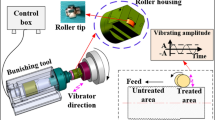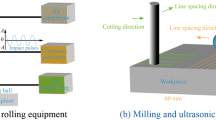Abstract
Yttria-stabilized zirconia (YSZ) ceramic is a widely used material in mechanical and biomedical engineering, such as machine parts and dental implants. For most applications, surface conditioning methods are required to produce smooth and reinforced surfaces with compressive residual stress. This paper investigates the processing characteristics of YSZ under ultrasonic vibration-assisted burnishing (UVB) enhanced by flexible stage and tool rotation techniques, respectively. For the use of flexible stage-enhanced UVB, the fluctuation of burnishing force was greatly reduced. As results, a smooth surface with a roughness of 164 nm Ra was obtained, which shows 39.7% surface roughness reduction from the original surface, and 9.4% surface roughness reduction from the surface burnished with conventional UVB. The burnished surface yielded strong residual compressive stresses of 401 MPa in the burnishing direction and 695 MPa in the step-feed direction. For the use of tool rotation-enhanced UVB, tool rotation-induced arc-shaped surface textures were formed on the burnished surface, and the textures became more distinct and denser as the rotation speed increased. The surface roughness was reduced by 58.9% from the original surface with the tool rotation-enhanced UVB. Stress-induced phase transformation of YSZ was identified in all burnished surfaces. This study demonstrates the feasibility of one-step manufacturing of a smooth surface with high residual compressive stress, which expands the applications of YSZ.




















Similar content being viewed by others
References
Garvie RC, Hannink RH, Pascoe RT (1975) Ceramic steel? Nature 258(5537):703–704
Soon G, Pingguan-Murphy B, Lai KW, Akbar SA (2016) Review of zirconia-based bioceramic: surface modification and cellular response. Ceram Int 42(11):12543–12555
Yin L, Nakanishi Y, Alao A, Song X, Abduo J, Zhang Y (2017) A review of engineered zirconia surfaces in biomedical applications. Proc CIRP 65:284–290
Lu A, Gao Y, Jin T, Luo X, Zeng Q, Shang Z (2020) Effects of surface roughness and texture on the bacterial adhesion on the bearing surface of bio-ceramic joint implants: an in vitro study. Ceram Int 46(5):6550–6559
Takahashi K, Iwanaka K, Koike H (2017) Increased fatigue strength of partially stabilised zirconia achieved by shot peening. Mater Sci Technol 33(5):623–628
Minguela J, Slawik S, Mücklich F, Ginebra MP, Llanes L, Mas-Moruno C, Roa JJ (2020) Evolution of microstructure and residual stresses in gradually ground/polished 3Y-TZP. J Eur Ceram Soc 40(4):1582–1591
Yan J, Okuuchi T (2019) Chip morphology and surface integrity in ultraprecision cutting of yttria-stabilized tetragonal zirconia polycrystal. CIRP Ann 68(1):53–56
Mahajan D, Tajane R (2013) A review on ball burnishing process. Int J Sci Res 3:1–8
Li FL, Xia W, Zhou ZY, Zhao J, Tang ZQ (2012) Analytical prediction and experimental verification of surface roughness during the burnishing process. Int J Mach Tools Manuf 62:67–75
Raza A, Kumar S (2022) A critical review of tool design in burnishing process. Tribol Int 174:107717
Huang W, Yan J (2023) Effect of tool geometry on ultraprecision machining of soft-brittle materials: a comprehensive review. Int J Extreme Manuf 5(1):012003
Huang W, Yan J (2021) Chip-free surface patterning of toxic brittle polycrystalline materials through micro/nanoscale burnishing. Int J Mach Tools Manuf 162:103688
Kumar VC, Hutchings IM (2004) Reduction of the sliding friction of metals by the application of longitudinal or transverse ultrasonic vibration. Tribol Int 37(10):833–840
Amanov A, Penkov OV, Pyun Y, Kim D (2012) Effects of ultrasonic nanocrystalline surface modification on the tribological properties of AZ91D magnesium alloy. Tribol Int 54:106–113
Teramachi A, Yan J (2019) Improving the surface integrity of additive-manufactured metal parts by ultrasonic vibration-assisted burnishing. J Micro Nano-Manuf 7(2):021001
Ding C, Feng S, Qiao Z, Zhou Z, Piao Z (2023) Running-in performance of 7075 aluminum alloy strengthened by burnishing technology. J Mech Sci Technol 37(5):2545–2553
Zhao J, Liu Z (2020) Plastic flow behavior for machined surface material Ti-6Al-4V with rotary ultrasonic burnishing. J Mater Res Technol 9(2):2387–2401
Travieso-Rodríguez JA, Jerez-Mesa R, Gómez-Gras G, Llumà-Fuentes J, Casadesús-Farràs O, Madueño-Guerrero M (2019) Hardening effect and fatigue behavior enhancement through ball burnishing on AISI 1038. J Mater Res Technol 8(6):5639–5646
Kosai K, Yan J (2020) Effects of cyclic loading on subsurface microstructural changes of zirconia polycrystals in nanoscale mechanical processing. Int J Mach Tools Manuf 159:103626
Takahashi K, Iwanaka K, Osada T, Koike H (2015) Increase in strength of partially stabilized zirconia after shot peening. J Mater Eng Perform 24(9):3573–3578
Zhuang Y, Zhu Z, Jiao T, Sun J (2019) Effect of aging time and thickness on low-temperature degradation of dental zirconia. J Prosthodont 28(1):e404–e410
Liu E, Xiao G, Jia W, Shu X, Yang X, Wang Y (2017) Strain-induced phase transformation behavior of stabilized zirconia ceramics studied via nanoindentation. J Mech Behav Biomed Mater 75:14–19
Muñoz-Tabares JA, Jiménez-Piqué E, Reyes-Gasga J, Anglada M (2011) Microstructural changes in ground 3Y-TZP and their effect on mechanical properties. Acta Mater 59(17):6670–6683
Acknowledgements
The authors thanks Areuse Co., Ltd. and Pulstec Industrial Co., Ltd. for providing technical supports.
Author information
Authors and Affiliations
Corresponding author
Ethics declarations
Conflict of interest
The authors declare that they have no conflict of interest.
Additional information
Publisher’s Note
Springer Nature remains neutral with regard to jurisdictional claims in published maps and institutional affiliations.
Rights and permissions
Springer Nature or its licensor (e.g. a society or other partner) holds exclusive rights to this article under a publishing agreement with the author(s) or other rightsholder(s); author self-archiving of the accepted manuscript version of this article is solely governed by the terms of such publishing agreement and applicable law.
About this article
Cite this article
Tsuchida, T., Huang, W. & Yan, J. Surface conditioning of zirconia ceramic by enhanced ultrasonic vibration-assisted burnishing. Prod. Eng. Res. Devel. 18, 353–366 (2024). https://doi.org/10.1007/s11740-023-01242-2
Received:
Accepted:
Published:
Issue Date:
DOI: https://doi.org/10.1007/s11740-023-01242-2




